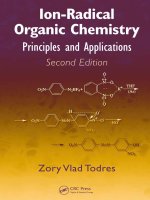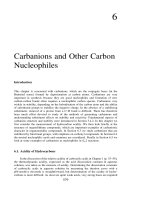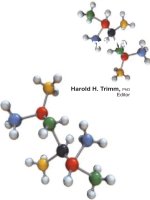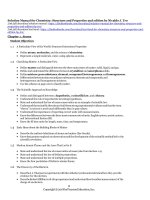Organic chemistry structure and mechanisms
Bạn đang xem bản rút gọn của tài liệu. Xem và tải ngay bản đầy đủ của tài liệu tại đây (6.71 MB, 367 trang )
Trimm
Organic Chemistry
Structure and Mechanisms
This book presents a range of research on important topics in the field. Of the approximately 11
million known chemical compounds, about 10 million are organic. Organic chemists are currently
working to produce better polymers with specific properties, such as biodegradable plastics. The
understanding of new drug structures from plants and the synthesis of improved pharmaceuticals
is another area of great interest. organic chemists are also researching the reactions that occur in
living systems and understanding the molecular causes of disease.
Organic Chemistry
Structure and Mechanisms
Other Titles in the Series
• Analytical Chemistry: Methods and Applications
• Inorganic Chemistry: Reactions, Structure and Mechanisms
• Physical Chemistry: Chemical Kinetics and Reaction Mechanisms
Related Titles of Interest
• Environmental Chemistry: New Techniques and Data
• Industrial Chemistry: New Applications, Processes and Systems
• Recent Advances in Biochemistry
Structure and Mechanisms
He received his PhD in chemistry, with a minor in biology, from Clarkson University in 1981 for his
work on fast reaction kinetics of biologically important molecules. He then went on to Brunel
University in England for a postdoctoral research fellowship in biophysics, where he studied the
molecules involved with arthritis by electroptics. He recently authored a textbook on forensic
science titled Forensics the Easy Way (2005).
Organic Chemistry
About the Editor
Dr. Harold H. Trimm was born in 1955 in Brooklyn, New York. Dr. Trimm is the chairman of the
Chemistry Department at Broome Community College in Binghamton, New York. In addition, he is
an Adjunct Analytical Professor, Binghamton University, State University of New York,
Binghamton, New York.
ISBN 978-1-926692-60-9
Harold H. Trimm, PhD
00000
Apple Academic Press
www.appleacademicpress.com
9 781926 692609
Research Progress in Chemistry
Apple
Academic
Press
Editor
www.pdfgrip.com
Organic Chemistry
Structure and Mechanisms
www.pdfgrip.com
This page intentionally left blank
www.pdfgrip.com
Research Progress in Chemistry
Organic Chemistry
Structure and Mechanisms
Harold H. Trimm, PhD, RSO
Chairman, Chemistry Department, Broome Community College;
Adjunct Analytical Professor, Binghamton University,
Binghamton, New York, U.S.A.
Apple Academic Press
www.pdfgrip.com
CRC Press
Taylor & Francis Group
6000 Broken Sound Parkway NW, Suite 300
Boca Raton, FL 33487-2742
Apple Academic Press, Inc
3333 Mistwell Crescent
Oakville, ON L6L 0A2
Canada
© 2011 by Apple Academic Press, Inc.
Exclusive worldwide distribution by CRC Press an imprint of Taylor & Francis Group, an Informa
business
No claim to original U.S. Government works
Version Date: 20120813
International Standard Book Number-13: 978-1-4665-5978-3 (eBook - PDF)
This book contains information obtained from authentic and highly regarded sources. Reasonable
efforts have been made to publish reliable data and information, but the author and publisher cannot
assume responsibility for the validity of all materials or the consequences of their use. The authors and
publishers have attempted to trace the copyright holders of all material reproduced in this publication
and apologize to copyright holders if permission to publish in this form has not been obtained. If any
copyright material has not been acknowledged please write and let us know so we may rectify in any
future reprint.
Except as permitted under U.S. Copyright Law, no part of this book may be reprinted, reproduced,
transmitted, or utilized in any form by any electronic, mechanical, or other means, now known or
hereafter invented, including photocopying, microfilming, and recording, or in any information storage or retrieval system, without written permission from the publishers.
For permission to photocopy or use material electronically from this work, please access www.copyright.com ( or contact the Copyright Clearance Center, Inc. (CCC), 222
Rosewood Drive, Danvers, MA 01923, 978-750-8400. CCC is a not-for-profit organization that provides licenses and registration for a variety of users. For organizations that have been granted a photocopy license by the CCC, a separate system of payment has been arranged.
Trademark Notice: Product or corporate names may be trademarks or registered trademarks, and are
used only for identification and explanation without intent to infringe.
Visit the Taylor & Francis Web site at
and the CRC Press Web site at
For information about Apple Academic Press product
www.pdfgrip.com
Contents
Introduction9
1. Mechanistic Aspects of the Isomerization of Z-Vinylic Tellurides
Double Bonds in the Synthesis of Potassium Z-Vinyltrifluoroborate
Salts
Hélio A. Stefani, Rafael C. Guadagnin, Artur F. Keppler,
Giancarlo V. Botteselle, João V. Comasseto and Carlos A. Suganuma
2. The Role of Heterogeneous Chemistry of Volatile Organic
Compounds: A Modeling and Laboratory Study
37
J. M. Frye and J. M. Kunkel
5. Analogues of Amphibian Alkaloids: Total Synthesis of
(5R,8S,8as)-(-)-8-Methyl-5-Pentyloctahydroindolizine
(8-Epi-Indolizidine 209B) and [(1S,4R,9as)-(-) -4Pentyloctahydro-2H-Quinolizin-1-Yl]Methanol
27
Stephen P. Marsden and Alison D. McElhinney
4. Application of Stir Bar Sorptive Extraction to Analysis of Volatile
and Semivolatile Organic Chemicals of Potential Concern in Solids
and Aqueous Samples from the Hanford Site
19
Gregory R. Carmichael and Vicki H. Grassian
3. Total Synthesis of the Indolizidine Alkaloid Tashiromine
11
Joseph P. Michael, Claudia Accone, Charles B. de Koning and
Christiaan W. van der Westhuyzen
49
www.pdfgrip.com
6 Organic Chemistry: Structure and Mechanisms
6. An Efficient Preparation, Spectroscopic Properties, and Crystal
Structure of 1,1-Bis(4-[2-(dimethylamino)ethoxy]phenyl)-2(3-guaiazulenyl)ethylene
Shin-ichi Takekuma, Seiki Hori, Toshie Minematsu and
Hideko Takekuma
7. Characterizing the Formation of Secondary Organic Aerosols
161
Florent Allais, Jean Boivin and Van Tai Nguyen
15. Part 3. Triethylborane-Air: A Suitable Initiator for Intermolecular
Radical Additions of S-2-Oxoalkyl-Thionocarbonates (S-Xanthates)
to Olefins
151
Jean Boivin and Van Tai Nguyen
14. Part 2. Mechanistic Aspects of the Reduction of S-Alkyl-
Thionocarbonates in the Presence of Triethylborane and Air
140
S. Höger, J. Weber, A. Leppert and V. Enkelmann
13. Part 1. Reduction of S-Alkyl-Thionocarbonates and Related
Compounds in the Presence of Trialkylboranes/Air
129
Sujit Kumar Ghorai, Saroj Ranjan De, Raju Karmakar,
Nirmal Kumar Hazra and Dipakranjan Mal
12. Shape-Persistent Macrocycles with Intraannular Alkyl Groups:
Some Structural Limits of Discotic Liquid Crystals with an
Inverted Structure
121
P. A. Turhanen and J. J. Vepsäläinen
11. Synthesis of Benzo[b]fluorenone Nuclei of Stealthins
109
Rafik Karaman
10. Unexpected Degradation of the Bisphosphonate P-C-P Bridge
Under Mild Conditions
102
Annabella F. Newton, Martin Rejzek, Marie-Lyne Alcaraz and
Robert A. Stockman
9. Accelerations in the Lactonization of Trimethyl Lock Systems are
Due to Proximity Orientation and not to Strain Effects
69
Melissa Lunden, Douglas Black and Nancy Brown
8. Combining Two-Directional Synthesis and Tandem Reactions,
Part 11: Second Generation Syntheses of (±)-Hippodamine and
(±)-Epi-Hippodamine
60
Jean Boivin and Van Tai Nguyen
171
www.pdfgrip.com
Contents 7
16. Catalytic Oxidative Cleavage of C=N Bond in the Presence of
Zeolite H-NaX Supported Cu(NO3)2, as a Green Reagent
A. Lalitha, K. Sivakumar, K. Parameswaran, K. Pitchumani and
C. Srinivasan
17. A Divergent Asymmetric Approach to Aza-Spiropyran Derivative
and (1S,8ar)-1-Hydroxyindolizidine
188
Jian-Feng Zheng, Wen Chen, Su-Yu Huang, Jian-Liang Ye and
Pei-Qiang Huang
18. Flexible Synthesis of Poison-Frog Alkaloids of the
5,8-Disubstituted Indolizidine-Class. II: Synthesis of (-)-209B,
(-)-231C, (-)-233D, (-)-235B”, (-)-221I, and an Epimer of 193E
and Pharmacological Effects at Neuronal Nicotinic Acetylcholine
Receptors
181
197
Soushi Kobayashi, Naoki Toyooka, Dejun Zhou, Hiroshi Tsuneki,
Tsutomu Wada, Toshiyasu Sasaoka, Hideki Sakai, Hideo Nemoto,
H. Martin Garraffo, Thomas F. Spande and John W. Daly
19. A Novel, One-Step Palladium and Phenylsilane Activated Amidation 207
from Allyl Ester on Solid Support
Zheming Ruan, Katy Van Kirk, Christopher B. Cooper and
R. Michael Lawrence
20. The First Organocatalytic Carbonyl-Ene Reaction: Isomerisation-
Free C-C Bond Formations Catalysed By H-Bonding Thio-Ureas
Matthew L. Clarke, Charlotte E. S. Jones and Marcia B. France
21. Synthesis and Biological Evaluation of 7-O-Modified
Formononetin Derivatives
229
Lukas Hintermann
23.CS2CO3 /[bmim]Br as an Efficient, Green, and Reusable
Catalytic System for the Synthesis of N-Alkyl Derivatives of
Phthalimide under Mild Conditions
221
Ying Yang, Wen-Jun Mao, Huan-Qiu Li, Tao-Tao Zhu, Lei Shi,
Peng-Cheng Lv and Hai-Liang Zhu
22. Expedient Syntheses of the N-Heterocyclic Carbene Precursor
Imidazolium Salts Ipr·Hcl, Imes·Hcl and Ixy·Hcl
214
Alireza Hasaninejad, Abdolkarim Zare, Ahmad Reza Moosavi-Zare,
Fatemeh Khedri, Rahimeh Rahimi and Ali Khalafi-Nezhad
239
www.pdfgrip.com
8 Organic Chemistry: Structure and Mechanisms
24. Conformational Rigidity of Silicon-Stereogenic Silanes in
Asymmetric Catalysis: A Comparative Study
Sebastian Rendler and Martin Oestreich
25. Photochromism of Dihydroindolizines Part XI: Synthesis of
Novel Carbon-Rich Photochromic Dihydroindolizines-Based
Potential Electronic Devices
271
Grigoriy Sereda, Jesse Van Heukelom, Miles Koppang,
Sudha Ramreddy and Nicole Collins
28. Three-Component One-Pot Synthesis of Novel Benzo[b]
1,8-naphthyridines Catalyzed by Bismuth(III) Chloride
264
Thomas A. Munro, Katharine K. Duncan, Richard J. Staples, Wei Xu,
Lee-Yuan Liu-Chen, Cécile Béguin, William A. Carlezon Jr.
and Bruce M. Cohen
27. Effect of Transannular Interaction on the Redox-Potentials in a
Series of Bicyclic Quinones
255
Saleh Abdel-Mgeed Ahmed
26. 8-Epi-Salvinorin B: Crystal Structure and Affinity at the K Opioid
Receptor
248
285
Tangali R. Ravikumar Naik, Halehatty S. Bhojya Naik,
Halehatty R. Prakasha Naik and P. J. Bindu
29. The Vicinal Difluoro Motif: The Synthesis and Conformation of
293
Erythro- and Threo-Diastereoisomers of 1,2-Difluorodiphenylethanes,
2,3-Difluorosuccinic Acids and their Derivatives
David O’Hagan, Henry S. Rzepa, Martin Schüler and
Alexandra M. Z. Slawin
30. The Influence of Traffic and Wood Combustion on the Stable
Isotopic Composition of Carbon Monoxide
315
M. Saurer, A. S. H. Prévôt, J. Dommen, J. Sandradewi,
U. Baltensperger and R. T. W. Siegwolf
31. Reduction of Arenediazonium Salts by Tetrakis(Dimethylamino)
Ethylene (TDAE): Efficient Formation of Products Derived
from Aryl Radicals
347
Mohan Mahesh, John A. Murphy, Franck LeStrat and
Hans Peter Wessel
Index366
www.pdfgrip.com
Introduction
Chemistry is the science that studies atoms and molecules along with their properties. All matter is composed of atoms and molecules, so chemistry is all encompassing and is referred to as the central science because all other scientific fields
use its discoveries. Since the science of chemistry is so broad, it is normally broken
into fields or branches of specialization. The five main branches of chemistry are
analytical, inorganic, organic, physical, and biochemistry. Chemistry is an experimental science that is constantly being advanced by new discoveries. It is the
intent of this collection to present the reader with a broad spectrum of articles in
the various branches of chemistry that demonstrates key developments in these
rapidly changing fields.
Organic chemistry is the study of compounds that contain the element carbon. Carbon is unique among the elements for its ability to bond to itself to form
long chains and a myriad of structures. Of the approximately 11 million known
chemical compounds, about 10 million are organic. New advances in organic
chemistry have allowed the production of better polymers with specific properties, such as biodegradable plastics. The elucidation of new drug structures from
plants and the synthesis of improved pharmaceuticals is another area of great
interest. Organic chemists are also researching the reactions that occur in living
systems and understanding the molecular causes of disease.
www.pdfgrip.com
10 Organic Chemistry: Structure and Mechanisms
These chapters will allow the reader to keep up with the latest methods and
applications being used in the twenty-first century, as well as other developments
in the field of organic chemistry.
— Harold H. Trimm, PhD, RSO
www.pdfgrip.com
Mechanistic Aspects of the
Isomerization of Z-Vinylic
Tellurides Double Bonds in
the Synthesis of Potassium
Z-Vinyltrifluoroborate Salts
Hélio A. Stefani, Rafael C. Guadagnin, Artur F. Keppler,
Giancarlo V. Botteselle, João V. Comasseto and Carlos A. Suganuma
Abstract
Through direct transmetalation reaction of Z-vinylic tellurides with nBuLi
was observed the unexpected isomerization of double bonds leading to potassium E-vinyltrifluoroborates salts in low to moderate yields. Using EPR spin
trapping experiments the radical species that promoted the stereoinversion of
Z-vinylic organometallic species during the preparation of potassium vinyltrifluoroborate salts was identified. The experiments support the proposed mechanism, which is based on the homolytic cleavage of the TenBu bond.
www.pdfgrip.com
12 Organic Chemistry: Structure and Mechanisms
Background
Boronic acids and boronate esters are the most commonly used derivatives in
Suzuki-Miyaura cross-coupling reactions. Recently, Molander et al.[1] and our
group [2] have explored the use of potassium organotrifluoroborate salts as an
alternative to the usual organoboron reagents in alkenyl-alkenyl,[3] aryl-aryl,[4]
alkenyl-alkynyl,[5] and alkenyl-aryl [6] cross-coupling reactions.
Distinct from the most commonly explored hydrometallation reactions, the
hydrotelluration of alkynes exclusively forms Z-vinylic tellurides. [7] Vinylic tellurides have the ability to undergo tellurium-metal exchange reactions with several
different commonly used, commercially available, or easily prepared organometallic reagents, leading to Z-vinyllithiums and Z-vinylcyanocuprates. In reactions
promoted by Pd or Ni, these compounds undergo stereospecific coupling with a
wide range of organic species. [8] The vinylic organometallic species obtained in
this way can also react with carbonyl compounds, α, β-unsaturated systems, or
epoxides [9-11] with complete retention of the double-bond stereochemistry
Taking advantage of the regio- and stereocontrol of the preparation of Zvinylic tellurides,[12] and of the unique features of the transmetallation with
complete retention of the original double bond geometry, we report herein the
synthesis of potassium vinyltrifluoroborate salts by means of the Te-Li exchange
reaction. To the best of our knowledge, this is the first reported preparation of
potassium E-vinyltrifluoroborate salts from Z-vinylic tellurides.
Results and Discussion
Functionalized Z-vinylic tellurides were prepared by hydrotelluration of alkynes.
[13] Using phenyl vinyl telluride, we performed a series of test reactions to establish the best reaction conditions for the lithium-boron exchange step (Table 1; ii,
Scheme 1). Optimum yield was obtained with B(OiPr)3 as the electrophile and
ether as the solvent (entry 6).
Scheme 1. Synthetic route used to prepare vinyl BF3K salts.
www.pdfgrip.com
Mechanistic Aspects of the Isomerization 13
Table 1. Lithium-Boron Test Reaction Conditions.
Using the optimized conditions (Table 1, entry 6), all the Z-vinylic tellurides
were, to our surprise, transformed into potassium E-vinyltrifluoroborate salts exclusively (Figure 1).
Figure 1. Isolated vinyl BF3K salts.
The 1H NMR spectra of the products showed the presence of the salt nBuBF3K as a by-product (30–50% of the total yield). Use of 1.0 equiv. of nBuLi
instead of 1.5 equiv. as in the optimized protocol gave the same proportion of
nBuBF3K.
With 1H NMR, we tried to observe the coupling constants of the vinylic hydrogens for each intermediate of the reaction route. Using this approach, we could
prove the cis geometry of the vinylic hydrogens of the intermediate 2(Scheme 1),
which presented a coupling constant of 18.09 Hz. [14,15] Unfortunately, the
boronic “ate” complex 4(Scheme 1) is an insoluble species and no 1H NMR
spectra were obtained. However, these results indicated that the double bond geometry isomerization occurred only after the formation of the intermediate 4
(Scheme 1).
www.pdfgrip.com
14 Organic Chemistry: Structure and Mechanisms
We suggest that homolytic cleavage of the Te-Bu bond, from 3 (i, Scheme 1),
generates nBu•, which is responsible for the cis-trans isomerization. The butyl
radical attack occurs at the boronic “ate” complex 4 (Scheme 1),[16] yielding the
nBuBF3K salt as a final product.
In order to verify the presence of radical species in the reaction mixture, we
performed EPR spin trapping experiments using 3,5-dibromo-4-nitrosobenzenesulfonate (DBNBS), which is an appropriate spin trap for tellurium centered radicals. [17] Radical species were detected at the i and ii steps of the proposed route.
In the first step (i, Scheme 1), the detected spectra contained a mixture of DBNBS
radical adducts (Figure 2A). The triplet of triplets (aN = 21.6 G, aH = 0.7 G,) is
the DBNBS/•TenBu radical adduct [17] and the broadened triplet (aN = 9.1 G,
aH = 1.0 G) can be attributed to another DBNBS radical adduct. The intensity of
the broadened triplet started to decay after 5 min incubation, and was barely detected in the 15 min incubation spectrum (Fig. 2B). The DBNBS/•TenBu signal
maintained its intensity during the course of the EPR analysis.
Figure 2. Representative EPR spectra of DBNBS radical adducts obtained during the Te-Li exchange reaction.
(A) EPR spectrum obtained after 1 min incubation of the reaction mixture with the DBNBS aqueous solution,
(B) EPR spectrum obtained after 15 min incubation of the reaction mixture with the DBNBS aqueous solution;
(ο) DBNBS/•TenBu radical adduct and (•) transient DBNBS radical adduct.
After the addition of the B(OiPr)3 (ii, Scheme 1), the reaction mixture produced a complex EPR spectra that can be attributed to a mixture of radical species
(Figure 3). The addition of the boron reagent generated different radical species
from those observed in the previous reaction step (Figure 2).
www.pdfgrip.com
Mechanistic Aspects of the Isomerization 15
Figure 3. Representative EPR spectrum of DBNBS radical adducts obtained during the Li-Boron exchange
reaction. EPR spectrum obtained after 15 min incubation of the reaction mixture with the DBNBS aqueous
solution.
We performed control experiments to exclude the possibility of radical generation by the combination of the boron reagent with O2 [18] or by the selfradical generation of the nBuTenBu reagent. Incubation of nBuTenBu, nBuLi
and B(OiPr)3 with DBNBS produced no EPR signals (Table 2, entries 3–5).
Equimolar solutions of nBuTenBu, nBuLi and DBNBS (Table 2, entry 6) produced a radical signal with similar parameters as those detected during the TeLi exchange (i, Scheme 1). In the absence of the reducing reagent (nBuLi), an
equimolar solution of nBuTenBu, B(OiPr)3 and DBNBS also did not produce
EPR signals (Table 2, entry 8).
Table 2. Reactions and Control Experiments Performed
To test our proposed mechanism, we repeated the reaction using (Z)-βbromostyrene, to achieve the desired Z-vinyllithium, the experiments were performed using tBuLi in a solution composed of THF/Et2O/petrol ether, at -120°C,
with and without nBuTenBu, instead of Z-vinylic tellurides to examine the effect
of the nBuTenBu as the source of the butyl radical. From this reaction, the expected potassium vinyltrifluoroborate salt was not isolated, probably because it
is necessary to use experimental conditions [19] that differ from those that were
selected to perform the synthesis of the BF3K salts. To maintain the same reaction
conditions, other control experiments were performed (Scheme 2).
www.pdfgrip.com
16 Organic Chemistry: Structure and Mechanisms
Scheme 2. Experimental conditions. i: 1 equiv nBuLi, Et2O, -78°C, 30 minutes.ii: 0.8 equiv B(OiPr)3, -20°C,
60 minutes.iii. 3 equiv KHF2 in aqueous solution, -20°C to r.t., 30 minutes.
Instead of having the double bond isomerization as a radical pathway model,
evidence of nBuTenBu radical behavior came from the detection of nBuBF3K
as a product only from experiment A (Scheme 2). With the control experiments
(Scheme 2), it was proven that the generation of nBuBF3K salt is dependent on
the presence of nBuTenBu, as well as that that occurs during the reaction to prepare the alkenyltrifluoroborate salts.
The results presented above support a free radical pathway for the trans-cis
double bond isomerization. Scheme 3 was proposed to account for the E-vinyl
and nBuBF3K salts. In the first step, the butyl radical 5 is formed by homolytic
cleavage of the nBu-Te bond of the compound 3, caused by the lithium species
present in the reaction medium. The second step consists of an attack of 5at the
boronic “ate” complex 4, leading to the vinylic radical, which undergoes selfisomerization to the most stable isormer 8. In the third step, the vinylic radical
8 attacks a B(OiPr)3 species, yielding an anionic vinyl boronic “ate” radical. The
boron-centered radical is then reduced by a •TenBu radical 6, leading to the Evinyltrifluoroborate salt 9 after the reaction work up with aqueous KHF2.
Scheme 3. Proposed mechanism of the reaction.
www.pdfgrip.com
Mechanistic Aspects of the Isomerization 17
Conclusion
In conclusion, we have identified the radical species that promoted the stereoinversion of vinylic compounds during the preparation of potassium vinyltrifluoroborate salts. The above experiments support the proposed mechanism, which is
based on the homolytic cleavage of the TenBu bond.
Acknowledgements
The authors wish to thank FAPESP (Grants 05/59141-6 and 03/01751-8 and the
scholarship 04/13978-1-AFK, 03-13897-7-RC), and CNPq agencies for financial support.
References
1. Molander GA, Ellis N: Acc Chem Res. 2007, 40:275.
2. Stefani HA, Cella R, Vieira AS: Tetrahedron. 2007, 63:3623.
3. Cella R, Orfão ATG, Stefani HA: Tetrahedron Lett. 2006, 47:5075.
4. Cella R, Cunha RLOR, Reis AES, Pimenta DC, Klitzke CF, Stefani HA: J Org
Chem. 2006, 71:244.
5. Stefani HA, Cella R, Dörr FA, Pereira CMP, Zeni G, Gomes M Jr: Tetrahedron
Lett. 2005, 46:563.
6. Stefani HA, Cella R: Tetrahedron. 2006, 62:5656.
7. Zeni G, Lüdtke DS, Panatieri RB, Braga AL: Chem Rev. 2006, 106:1032.
8. Zeni G, Braga AL, Stefani HA: Acc Chem Res. 2003, 36:731.
9. Barros SM, Comasseto JV, Barriel JN: Tetrahedron Lett. 1989, 30:7353.
10. Hirro T, Kambe N, Ogawa A, Miyoshi N, Murai S, Sonoda N: Angew Chem,
Int Ed Engl. 1987, 11:1187.
11. Marino JP, Tucci FC, Comasseto JV: Synlett. 1993, 761.
12. Barros SM, Dabdoub MJ, Dabdoub VB, Comasseto JV: Organometallics. 1989,
8:1661.
13. Zeni G, Formiga HB, Comasseto JV: Tetrahedron Lett. 2000, 41:1311.
14. Nesmeyanov AN, Borisov AE: Tetrahedron. 1957, 1:158.
15. Seyferth D, Vaughan LG: J Am Chem Soc. 1964, 86:883.
16. Pozzi D, Scanlan EM, Renaud P: J Am Chem Soc. 2005, 127:14204.
www.pdfgrip.com
18 Organic Chemistry: Structure and Mechanisms
17.Keppler AF, Cerchiaro G, Augusto O, Miyamoto S, Prado F, Di Mascio P,
Comasseto JV: Organometallics. 2006, 25:5059.
18. Cadot C, Cossy J, Dalko PI: Chem Commun. 2000, 1017.
19. Neumann H, Seebach D: Tetrahedron Lett. 1976., 52: 4839.
www.pdfgrip.com
The Role of Heterogeneous
Chemistry of Volatile Organic
Compounds: A Modeling and
Laboratory Study
Gregory R. Carmichael and Vicki H. Grassian
Overview
The outputs of this research have been reported annually via the RIMS system.
This report serves as an update and final report. The focus of our DOE BES
funded project is on the importance of heterogeneous reactions in the troposphere. The primary objectives of our study were to: (i) Evaluate the extent to
which heterogeneous chemistry affects the photochemical oxidant cycle, particularly, sources and sinks of tropospheric ozone; and (ii) Conduct laboratory studies
on heterogeneous reactions involving NOy, O3 and VOCs on aerosol surfaces.
These objectives were pursued through a multidisciplinary approach that combines modeling and laboratory components as discussed in more detail below. In
addition, in response to the reconfiguring of the Atmospheric Science Program
www.pdfgrip.com
20 Organic Chemistry: Structure and Mechanisms
to focus on aerosol radiative forcing of climate, we also began to investigate the
radiative properties of atmospheric aerosol.
Laboratory Studies
We investigated heterogeneous reactions involving ozone, nitrogen oxides and
volatile organics on mineral dust and carbonaceous aerosol using a variety of techniques that we have developed over the course of the grant period. In addition to
investigating heterogeneous reactions, we begun to measure the optical properties
of these tropospheric aerosol so as to further our understanding of the scattering
and absorption of aerosol in the context of climate change. Of particular interest
here is the relationship between heterogeneous chemistry and changes in the optical properties of mineral dust and carbonaceous aerosol. This helps us understand
how aerosol chemistry and climate are interconnected.
Heterogeneous Reactions of O3 on Mineral Dust
We studied the initial reactive uptake of ozone on several mineral oxides, clays
and authentic dust samples. In those studies, a Knudsen cell was used and it
was determined that the initial uptake coefficient was 2.0 +/- 0.3x10-4 for alphaFe2O3, 1.2 +/- 0.4x 10-4 for α-Al2O3, 6.3 +/- 0.9 x 10-5 for SiO2 and 3 +/- 1 x 10-5
for kaolinite. The γo,BET for authentic dusts, Saharan sand and China loess was
determined to be 6 +/- 2 x 10-5 and 2.7 +/- 0.8 x 10-5, respectively. It was also
shown that after long ozone exposure experiments demonstrated that the mineral
oxide surfaces did not passivate, rather they approached non-zero steady-state
uptake values, which were lower by approximately 80% from the initial values.
However, the mineral oxide powders and dusts exhibited catalytic behavior with
the destruction of many more ozone molecules than the total number of surface
sites present on the particles. Furthermore, we discussed that the process of ozone
adsorption onto mineral oxide surfaces showed a weak temperature dependence,
consistent with a low energy of activation.
More recently, we began to consider the effect of coatings on the particle surface. For example, as particles age in the atmosphere they become coated with
organic and inorganic coatings. Therefore, laboratory measurements of the reactive uptake on these “clean” powders may be somewhat different from the particles encountered in the atmosphere. In our most recent published study, laboratory experiments were done to simulate changes in the reactivity of mineral dust
particles after being processed or aged in the atmosphere. Initial uptake coefficients of ozone on processed and unprocessed dust was measured with a Knudsen
cell reactor and the relative reactivities are compared. In particular, the reactive
www.pdfgrip.com
The Role of Heterogeneous Chemistry of Volatile Organic Compounds 21
uptake of ozone with mineral oxide particles that had been pretreated by exposure
to nitric acid, sulfur dioxide, and organics are compared to particles that had not
been pretreated. In some cases, it was found that the reactivity of ozone with pretreated particles was significantly reduced whereas in other cases the reactivity was
enhanced. For example, the reactive uptake of ozone decreased by approximately
70% for α-Al2O3 particles coated with a layer of nitrate from reaction of nitric
acid compared to particles that did not have a nitrate coating, whereas pretreatment of α-Al2O3with sulfur dioxide showed a 33% enhancement toward ozone
reactivity. For organic coatings, it was determined that SiO2 particles functionalized with a C8-alkene displayed enhanced reactivity toward ozone by 40% relative
to untreated SiO2, while SiO2 particles functionalized with a C8-alkane exhibited
decreased reactivity by approximately 40% relative to untreated SiO2particles.
The reaction mechanism of ozone uptake with these particles is attributed to the
presence and blocking of particular sites on the particles surface causing both a
decrease and increase in the reactivity of the particles. Clearly the interaction of
these particles with gases prior to exposure to ozone produces changes in the reactivity of the particles toward ozone. Atmospheric models describing the chemistry
of the troposphere should not only take into account heterogeneous reactions of
ozone, but also adjust the values used according to the history of the particles.
Mineral dusts that have accumulated a coating of nitrate or aliphatic material will
affect the ozone less than mineral dusts that have accumulated coatings of sulfite
or olefins, and the differences can potentially influence the partitioning of ozone
in significant ways.
Another important coating is that of adsorbed water. The Knudsen cell apparatus used in the experiments discussed above were limited to much drier
conditions than typically found in the atmosphere. We have begun a series of
experiments using an environmental aerosol chamber to investigate the destructive uptake of ozone as a function of relative humidity. Thus far, we have determined that for ozone destruction on iron oxide, the most reactive oxide studied,
adsorbed water can influence the rate of ozone destruction. Our studies as well
as literature data indicate that water adsorbs onto the most reactive sites on the
surface, namely Lewis acid sites. These studies are ongoing and will be completed
in the near future.
Heterogeneous Reactions of Organic and Inorganic Acids with
Calcium Carbonate as a Function of Relative Humidity: Studies Using
Single Particle Analysis and an Environmental Aerosol Chamber
Calcium carbonate is a common component of mineral dust and may in fact be a
very reactive component of the aerosol present in the Earth’s atmosphere. The heterogeneous chemistry of individual calcium carbonate particles with nitric acid at
www.pdfgrip.com
22 Organic Chemistry: Structure and Mechanisms
293 K has been followed using Scanning Electron Microscopy (SEM) and Energy
Dispersive X-Ray (EDX) analysis as a function of time and relative humidity
(RH). The rate of calcium carbonate to calcium nitrate conversion is significantly
enhanced in the presence of water vapor. As discussed in the last report, the SEM
images clearly show that solid CaCO3 particles are converted to spherical droplets
as the reaction proceeds. The change in phase of the particles and the significant
reactivity of nitric acid and CaCO3 at low RH is a direct result of the deliquescence of the product, calcium nitrate, below 20% RH. The reaction efficiency is
enhanced at higher relative humidity. We have done a series of experiments in the
last year at the EMSL at Pacific Northwest National Laboratory on reactions of
calcium carbonate with organic acids as well as reaction of authentic dust samples
with nitric acid. Reaction of calcium carbonate with acetic acid does not show
similar morphology changes as that with nitric acid. This is thought to be due
to the fact that calcium acetate undergoes deliquescence at much higher relative
humidity. Reaction of four different authentic dust samples from different arid
regions around the world shows that the reaction with nitric acid with the carbonate component of the dust reacts in the same way as commercial samples.
Complementary experiments using our environmental aerosol chamber which
is able to measure the absorption and scattering properties of tropospheric aerosol over a wide range of wavelengths show that the nitric acid reacted carbonate
particles scatter infrared radiation differently from the unreacted particles. The
observed changes in the optical properties of the aerosol are consistent with the
changes in morphology and chemical composition of the aerosol as it reacts. We
have been able to model the absorption and scattering properties of unreacted
calcium carbonate as well as the reacted particles using Mie theory. Mie theory
does a fairly good job in fitting the experimental data, however we are currently
working on using other scattering theories to determine if they provide a better
fit the experimental data.
Modeling Analysis
We used these field experiments as a way to evaluate the importance of the new
chemistry arising from the laboratory. The high dust environments of Asia provide the best real environment for looking at the role of heterogeneous chemistry.
Our recent results are summarized below.
Dust influences on regional gas-phase chemistry can be classified into heterogeneous influences and radiative influences, and both were studied. In our
analysis we introduced four heterogeneous reactions involving O3, NO2, SO2
and HNO3 reactions on dusts, with reaction rates determined based on Prof.
Grassian’s laboratory studies. The C-130 flight 6 was significantly affected by
www.pdfgrip.com
The Role of Heterogeneous Chemistry of Volatile Organic Compounds 23
heterogeneous and radiative influences. The O3 heterogeneous uptake on dust
had a significant impact on flight 6, accounting for a 20 ppbv decrease in ozone
levels. Only when this reaction was included in the model were we able to represent the observed values. This reaction was shown to cause a broad decrease in
background O3. In polluted areas, this low O3 background reduced NO2 production, but caused NO enhancement. The impact of the O3 heterogeneous loss on
NO2 was usually stronger than that due to the direct NO2 reaction on dust. As a
result of these reactions HONO levels increased by up to 30% in some polluted
areas. The radiative influence of dust on photochemistry was largest for HOx. For
ozone, radiative influence of aerosols was large, but the contribution due to dust
was not as strong as the influences of the heterogeneous reactions.
The presence of dust was also shown to enhance sulfate production by 10 to
40% in dust rich regions, and to result in an increase in sulfate amount in the
coarse fraction. Reactions involving NO2 and nitric acid were shown to result in
the accumulation of nitrate into the aerosol, and this occurs mainly in the coarse
mode (however, appreciable amounts may also appear in the fine mode).
We have extended the analysis using a version of our model that incorporated
an on-line, size-resolved, aerosol thermodynamics model (SCAPE-II). This model
was used to further study the aerosol ion distributions, and factors that influence
the composition-size relationships, in the East Asia outflow during the TRACE-P
and ACE-Asia periods. Results from the model were compared with various observations, and used to study how the inorganic aerosol composition changed as
airmasses travel off the continent and out over the western Pacific.
Dust was shown to strongly affect the aerosol ions and their size distributions.
Results from this study indicated that dust alters the partitioning of the semi-volatile components between the gas and aerosol phases as well as the size distributions of the secondary aerosol constituents. A main role of dust in the equilibrium
process is through the enhancement of the aerosol calcium concentration, which
shifts the equilibrium balance to an anion-limited status. This status benefits the
uptake of sulfate and nitrate, but repels ammonium. Surface reactions on dust
provide an additional mechanism to produce aerosol nitrate and sulfate. The size
distribution of dust was shown to be a critical factor. As much of the dust mass
resides in the coarse mode (70-90%), appreciable amounts of sulfate and nitrate
are in the super-micron particles. For sulfate the observations and the analysis
indicate that 10-30% of sulfate was in the coarse fraction. In the case of nitrate
more than 80% was found in the coarse fraction. The strength of dust influence
was shown to be determined by its fresh ratio and concentration.
The results of this analysis also point out remaining issues and challenges for
the model and measurements. From the modeling perspective the results were
found to be very sensitive to the dust mass, its size distribution, assumptions
www.pdfgrip.com
24 Organic Chemistry: Structure and Mechanisms
about its extent of equilibrium involvement, and the fraction of the aerosol mass
available for reaction. Estimating dust mass and size distributions using emission
models is fraught with uncertainty. Results obtained in ACE-Asia and TRACE-P
have allowed for more rigorous evaluation of model prediction of dust, and provided more details into the dust size distribution. As a result we have improved
our ability to estimate dust emissions in East Asia; but quantitative, episodic, and
predictive capabilities remain a challenge.
The issue of how to characterize the chemically active portion of the aerosol
presents a challenge. Our modeling studies suggest that an appreciable fraction of
the calcium in the aerosol in the outflow while internally mixed may be chemically in-active. Quantifying the chemical – activity state from the observations
is difficult, and can not be determined by composition measurements by themselves. Microscopy and single particle techniques provide important information.
At present the information provided from the single particle statistics derived
from particle numbers and the model mass-based predicts do not correspond.
Our results show how these can be used together to provide useful information
and aid in the interpretation, but ways to facilitate more quantitative comparisons
need to be found.
These results suggest that present day atmospheric models have substantial
interpretive and diagnostic capabilities. However the results presented here also
point out that improvement in our predictive capability will require substantial
reductions in uncertainties. Continued integration of models and measurements
are clearly needed. More detailed considerations of the possible effects of surface
saturation, as well as competition for reactions on other surfaces such as BC need
to be considered. These effects, as well as a comprehensive comparison of across
the ACE-ASIA measurements are the subjects that we will focus on in 2004.
Products Delivered
Publications
1. A. D. Clarke, Y. Shinozuka, V. N. Kapustin, S. Howell, B. Huebert, S. Doherty, T. Anderson, D. Covert, J. Anderson, X. Hua, K. G. Moore II,
C. McNaughton,G. Carmichael and R. Weber, Size distributions and mixtures
of dust and black carbon aerosol in Asian outflow: Physiochemistry and optical
properties, J. Geophys. Res., 109, D15S09.
2. Cameron S. McNaughton, Antony D. Clarke, Steven G. Howell, Kenneth G.
Moore II, Vera Brekhovskikh, Rodney J. Weber, Douglas A. Orsini, David S.
Covert, Gintautas Buzorius, Fred J. Brechtel, Gregory R. Carmichael, Youhua









